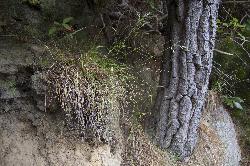- Taxon
- Gallery
- ≡ Danthonia unarede Raoul, Ann. Sci. Nat., Bot. sér. 3, 2: 116 (1844)
- ≡ Danthonia semiannularis var. unarede (Raoul) Hook.f., Bot. Antarct. Voy. II. (Fl. Nov.-Zel.) Part I, 304 (1853)
- ≡ Notodanthonia unarede (Raoul) Zotov, New Zealand J. Bot. 1: 122 (1963)
- ≡ Thonandia unarede (Raoul) H.P.Linder (1996) nom. illeg.
- = Danthonia cingula Steud. (1853)
Strong tufts spreading outwards from ± open centre, very shortly rhizomatous, mostly glabrous apart from apical tuft of hairs but not invariably so; leaves slightly < mature culms; branching extravaginal. Leaf-sheath pale stramineous, usually glabrous but some with long, scattered to very occasionally abundant, fine hairs, rarely all sheaths hairy; apical tuft of hairs to 4 mm. Ligule 0.2–0.8 mm. Leaf-blade flat, or margins inrolled, to 40 cm × 3.5 mm, glabrous, occasionally a few scattered long hairs, margins finely scabrid. Culm to 75–(85) cm, internodes smooth but finely scabrid below inflorescence. Panicle narrow, long-branched, to 15–(18) cm, of large spikelets on short slender pedicels; rachis and pedicels densely short-scabrid, occasionally with a few longer hairs below spikelets and at branch axils. Spikelets (3)–4–6–(8)-flowered, awns exserted from glumes. Glumes purplish centrally, lanceolate, acute or subacute, ± equal, (7.5)–10–12 mm, both 5–(7)-nerved. Lemma 2–3 mm, 9-nerved, both upper and lower rows of hairs dense, continuous, upper row < lemma lobes, lower row only reaching base of upper, some few scattered hairs elsewhere and on margins; lobes (4)–5–7 mm, gradually tapering to fine awns; central awn (6)–9–12 mm, column (1)–2–3 mm, ≥ palea, usually ≈ upper lemma hairs. Palea 4–5 mm, slightly < upper lemma hairs, interkeel glabrous or rarely a few hairs, margins a few long hairs or glabrous. Callus 0.5–0.8 mm, with marginal hair tufts overlapping lower lemma hairs. Rachilla 0.4–0.6–(0.7) mm. Anthers 0.3–0.8 and 1–1.6 mm. Caryopsis 1.6–1.8 × 0.8–0.9 mm; embryo 0.8 mm; hilum 0.5 mm. Plate 12F.
[From: Edgar and Connor (2000) Flora of New Zealand. Volume 5 (second printing).]




